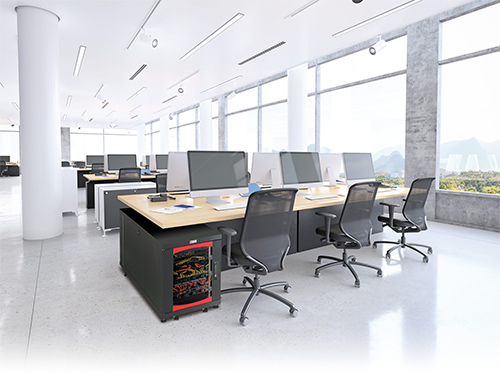TABLE RACK FOR NETWORKING
A table rack for networking, also known as a tabletop network rack or a desk-mount network rack, is a type of rack designed to sit on a table or desk surface, providing a compact and convenient solution for housing networking equipment. Additionally, there are several rack accessories available that can enhance the functionality and organization of a networking rack. Here's an overview of table racks for networking and some common rack accessories:
Table Rack for Networking:
1. Compact design: Table racks are typically smaller in size compared to floor-standing racks or wall-mount racks. They are designed to sit on a table or desk, making them suitable for small office spaces or home networking setups.
2. Easy access and mobility: Table racks offer easy accessibility to network equipment. They can be placed within arm's reach, allowing for convenient maintenance, management, and troubleshooting. They are also portable, making it easier to move or reposition the rack as needed.
3. Cable management: Many table racks include cable management features to help organize and route network cables effectively. These features may include cable routing holes, cable ties, or cable management panels, helping to reduce cable clutter and improve airflow.
4. Equipment protection: Table racks provide a secure and stable platform for housing networking equipment, such as switches, routers, and modems. They help protect the equipment from accidental damage and keep it elevated from the table surface to prevent overheating.
5. Flexibility and scalability: Table racks often come in modular designs, allowing for flexibility and scalability. You can add or remove shelves, drawers, or other accessories as needed to accommodate different types and sizes of network equipment.
Common Rack Accessories:
1. Rack shelves: Shelves can be added to the rack to provide additional space for non-rack-mountable devices, such as modems, power supplies, or storage devices.
2. Cable management panels: These panels are used to organize and route cables neatly within the rack, ensuring a clean and efficient cabling system.
3. Patch panels: Patch panels are used to terminate and manage network cables, providing a central point for connecting devices.
4. Cooling fans: Cooling fans can be installed to improve airflow within the rack, helping to dissipate heat generated by network equipment and prevent overheating.
5. Power distribution units (PDUs): PDUs offer a convenient way to distribute power to multiple devices within the rack, providing surge protection and additional power outlets.
6. Rack-mount drawers: Drawers provide storage space within the rack for small accessories, tools, or documentation.
7. Rack-mount cable organizers: These accessories help secure and organize cables within the rack, reducing tangles and improving cable management.
When selecting a table rack or rack accessories, consider factors such as the size and weight capacity of the rack, the specific requirements of your network equipment, and the available space on your table or desk. It's important to ensure that the rack and accessories are compatible with the equipment you plan to install and meet industry standards for safety and reliability.



